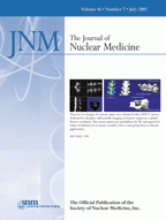TO THE EDITOR:From their study of hypothyroid patients referred for brain SPECT, Krausz et al. (1) found that, compared with control subjects, these patients showed hypoperfusion in posterior areas of the brain but preservation of perfusion in the amygdala and hippocampi. To date, the pathogenesis of this regional hypoperfusion remains unclear and not easily attributable to direct effects of thyroid hormones on cerebral vessels. We advance an alternative hypothesis based on deafferentation and local synaptic plasticity.
Burmeister et al. (2) showed that the memory deficits observed during hypothyroidism were specific and could be related to dysfunction of the hippocampus, which is rich in thyroid hormone receptors and implicated in deficits in episodic memory. However, previous studies showed that perfusion and metabolism were preserved in the mesial temporal cortex of hypothyroid patients and that, by contrast, abnormalities were observed in posterior associative cortices and in the cingulum. This apparent paradox of conservation of perfusion in presumed dysfunctional regions and distant regional hypoperfusion has been observed in the prodromal phase of Alzheimer’s disease (AD). In AD, brain lesions start in the internal face of the temporal cortex but SPECT images reveal posterior hypoperfusion similar to that observed during hypothyroidism. In early stages of AD, these cortical regions are usually anatomically preserved from pathologic lesions, and SPECT features have been attributed to a functional remote effect by deafferentation of brain regions connected mainly with the mesial temporal cortex (3). This assumption has been validated for glucose metabolism in primates with neurotoxic lesions of the entorhinal and perirhinal cortices (4).
In addition, a local compensation synaptic plasticity observed in AD and hypothyroidism could explain the normality of perfusion in the mesial temporal cortex (5).
On the basis of the medical literature and our experience, SPECT findings in hypothyroid patients closely replicated the pattern observed in early-stage AD patients, combining preserved perfusion in the mesial temporal cortex and hypoperfusion in the posterior associative cortex. These 2 entities could represent a model of lesional (AD) or functional (hypothyroidism) dysfunction of the mesial temporal cortex caused by deafferentation and local synaptic plasticity.
REFERENCES
REPLY:
We thank Drs. Guedj, Taïeb, De Laforte, Ceccaldi, and Mundler for their constructive comments. Indeed, the pathogenesis of the regional abnormalities in cerebral blood flow in hypothyroidism remains unclear. In their letter, Guedj et al. suggest a hypothesis based on deafferentation and local synaptic plasticity.
Their comments assuming medial temporal lobe dysfunction in hypothyroidism are largely based on the work of Burmeister et al. (1), who argue that cognitive compromise in hypothyroidism is specific to faculties mediated by the medial temporal lobe. Although not explicitly stated in their letter, this localization is of particular import given the high density of thyroid-hormone receptors in these regions (2). Still, caution is warranted before definitive conclusions are drawn.
The extent of cognitive dysfunction in patients with hypothyroidism, particularly with mild endocrine dysfunction, varies. Deficits range from minimal to extensive, including impairments in attention and working memory, executive functions, and visuospatial processing (3), mediated by the frontal, parietal, and posterior cingulate cortices. Interestingly, the few imaging studies of hypothyroidism-related dementia present an overall similar picture of widespread, diffuse perfusion deficits localized mostly to the temporoparietal regions (4,5). Thus, imbalance in thyroid function may give rise to cognitive deficits that are mediated by the same neurocircuitry. In fact, some authors maintain that a pathophysiologic link exists between Alzheimer’s disease and thyroid dysfunction or thyroid-related autoantibodies in certain patient populations (6), although other studies have reached a negative conclusion with regard to this association (7). Therefore, the scintigraphic similarity between Alzheimer’s disease and hypothyroidism may be related to reasons other than the deafferentation model proposed by Guedj et al.
The most consistent finding from brain imaging studies of patients with hypothyroidism is global, diffuse hypoperfusion, rather than specific sparing of the medial temporal lobe. Actually, recent research suggests that perfusion deficits may particularly be localized to posterior brain regions (8,9). Even in studies reporting a global decrease in CBF, the decrease is most prominent in the parietal lobe (10). Moreover, it is unclear whether hypothyroid-associated perfusion deficits persist after resumption of the euthyroid state and clinical remission. Both our study (8) and the recent study of Nagamachi et al. (9) reported persistence of hypoperfusion when patients were examined shortly after thyroid hormone replacement was instituted. In contrast, albeit in a single case study, resolution of perfusion deficits in dementia associated with hypothyroidism required more than a year (4). Therefore, resolution of scintigraphic perfusion deficits in hypothyroidism may lag behind clinical, including cognitive function, improvement.
To summarize, although the model of deafferentation and local synaptic plasticity of Guedj et al. may be plausible, additional research at the clinical, neuropsychological, neuroimaging, and molecular levels is required before a definitive mechanism explaining perfusion deficits in hypothyroidism can be determined.







